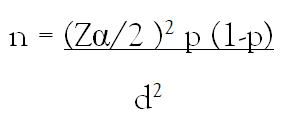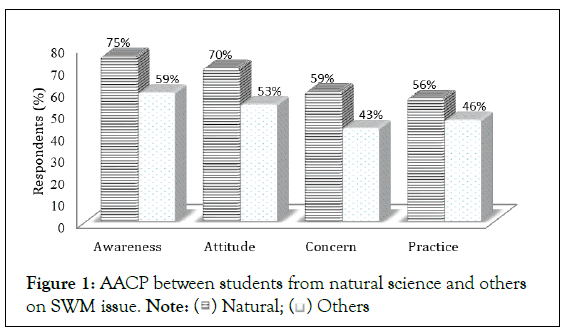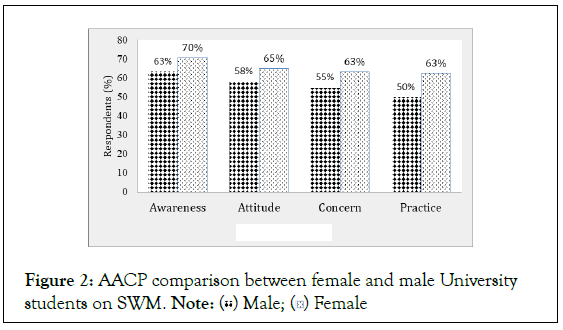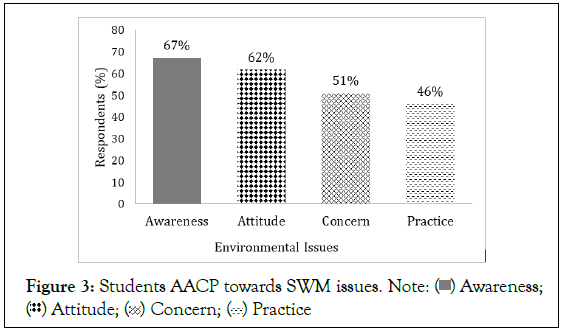Indexed In
- Open J Gate
- The Global Impact Factor (GIF)
- Open Archive Initiative
- VieSearch
- International Society of Universal Research in Sciences
- China National Knowledge Infrastructure (CNKI)
- CiteFactor
- Scimago
- Ulrich's Periodicals Directory
- Electronic Journals Library
- RefSeek
- Directory of Research Journal Indexing (DRJI)
- Hamdard University
- EBSCO A-Z
- Publons
- Google Scholar
Useful Links
Share This Page
Journal Flyer

Open Access Journals
- Agri and Aquaculture
- Biochemistry
- Bioinformatics & Systems Biology
- Business & Management
- Chemistry
- Clinical Sciences
- Engineering
- Food & Nutrition
- General Science
- Genetics & Molecular Biology
- Immunology & Microbiology
- Medical Sciences
- Neuroscience & Psychology
- Nursing & Health Care
- Pharmaceutical Sciences
Research Article - (2022) Volume 12, Issue 4
Attitude, Awareness, Concern and Practice (AACP) towards Solid Waste Management among University Students: A Case Study in Kotebe Education University in Addis Ababa
Adane Sirage Ali*, Negassa Bekela and Mekdes MengistuReceived: 15-Apr-2022, Manuscript No. IJWR-22-16145; Editor assigned: 20-Apr-2022, Pre QC No. IJWR-22-16145(PQ); Reviewed: 04-May-2022, QC No. IJWR-22-16145; Revised: 11-May-2022, Manuscript No. IJWR-22-16145(R); Published: 21-May-2022, DOI: 10.35248/2252-5211.22.12.461
Abstract
Solid Waste Management (SWM) is the major challenge throughout the nation. SWM strategy and facility are poor; public awareness is very low; public perception of SWM is not good; individual responsibility and accountability to the problem are extremely low. Regarding solid waste management, it seems there is no difference between educated and non-educated individuals in the community. Therefore, this study was designed to investigate the awareness, attitude, concern, and practice regarding SWM problems and their management among University students. The study was conducted at Kotebe Metropolitan University using a close-ended questionnaire, individuallevel observation, and follow-ups. The result of the study indicated that about 62%, 51%, and 46% of the students have good awareness, attitude, concern, and practice respectively toward SWM issues. It was displayed that students have good awareness and moderate attitude towards SWM issues, but are less concerned and don’t practice. Because of their close intimacy with the environment and cultural influence, female students were better at all SWM issues than their male counterparts. Students from natural science faculty have good awareness (75%) and better attitude (70%) than students from social science departments. This is obviously due to the influence of their educational background. The result of this research clearly showed that the AACP of University students towards SWM was influenced by gender and educational background.
Keywords
Attitude; Awareness; Concern; Solid waste management; University student
Introduction
Environmental pollution has attracted much attention all over the world. While cities are generating an ever-increasing volume of waste, the effectiveness of their solid waste collection and disposal systems is declining. In urban centers throughout African countries, less than half of the solid waste produced is collected. Approximately 95% of that amount is either indiscriminately thrown away at various dumping sites on the periphery of urban centers, or at several so-called temporary sites, typically empty lots scattered throughout the city [1]. This is true in almost all Ethiopian villages, towns, and cities.
Environmental problems need to be tackled at the individual level, requiring individuals to develop those attitudes and perceptions. This will guide them to environmentally supportive behavior [2]. In Ethiopia, it is very common to see tissues, papers, plastics, festal, litter, old clothes, shoes, etc at the roadside and building corridors. Drainages are clogged up with rubbish, and rivers, instead of being an attraction, are filled with filthy garbage with a strong repellant smell. Individuals recklessly throw solid wastes into their surroundings shamelessly everywhere. It will be a surprise if you see individuals or groups showing a concern, opposing improper solid waste disposal practices. We can say that such kind misbehavior and wrongdoings are due to a lack of awareness, wrong perception, lack of concern, and responsibility to the environment in the society.
University students are part of society. They are expected to bring a change of behavior and develop feelings of responsibility and concern in their campus stay and the thereafter career life. However, there is no research conducted on how University students behave, are concerned, and respond to environmental issues. No assessment unveiled whether University students and graduates are behaviorally different from the society regarding SWM issues. Moreover, evidence showing whether the University education/ courses bring a change in their environmental perception, concern, and responsibility is nil. Therefore, considering all the aforementioned problems, this research was designed to investigate the attitudes, awareness status, concerns, and practices regarding SWM issues among University students in Ethiopia.
Research questions
This study addresses the following research questions:
1. What is the students’ level of awareness, attitude, concern, and practice about the environment?
2. Does students’ educational background affect the four dimensions of environmental issues?
3. What is the relationship between the students’ level of awareness, attitude, concern andpractice towards the environment?
4. Is gender a factor in students’ actions towards the environment?
Methodology
Sampling design, sample size, and sampling techniques
All required data for this study were collected only from primary sources at Kotebe Metropolitan Education University. The data were collected in two ways: using a questionnaire and individual level observation (follow-up).
Data collection technique
Different scales of the close-ended self-administered questionnaire were used. The questionnaire consisted of 16 items distributed into four dimensions: Attitude (A) (4 items), Awareness (A) (4 items), Concern for solid wastes (C) (4 items), and Practices (P) toward SWM issues (4 items). The items in the questionnaire were a type of “YES or NO” question. Students were stratified by gender and college (Natural Science (Natural) and Social Science base students (Social)). The sample size (n) was determined from a known student population of about 3,000 using the following formula.

Where, (Zα/2)=Reliability coefficient=1.96
n=Sample size
p=50% this is because similar studies will be difficult to find
d=Assumed marginal error (5%)
10% non-response rate will be added
A total of 384 students were used to estimate “n” with 95% confidence. Correction for the small finite population was not made (Table 1).
| Gender | Natural science departments (n) | Social science departments (n) |
|---|---|---|
| Male | 96 | 96 |
| Female | 96 | 96 |
| Total | 192 | 192 |
Table 1: Sample size (n) specification.
After the sample size (n) was determined, data were collected from students selected through stratified random sampling.
Individual-level observation
For the individual-based follow-up observation, about half the number of students (200) was randomly chosen from the total sample size. Data collectors were following up on randomly selected students’ practices and concerns for two weeks. Specific activities such as how they dispose of solid wastes, how they respond when they see somebody disposing of wastes improperly; do they pick solid wastes on their way; do they show a positive attitude towards somebody picking waste or cleaning the area etc. were carefully registered.
Results and Discussion
AACP of students from natural science and social science colleges on SWM issues
AACP of natural science and non-natural science faculty students towards SWM issues were compared and the result showed that students from natural science outperformed much better than students from other faculties in all the four dimensions of the selected criteria. The result was statistically significant (p<0.05). For instance, about 75% and 70% of students from natural science students have good awareness and high attitude toward SWM respectively; whereas students from non-natural science departments, only about 59% and 53% of them have good awareness and attitude respectively (Figure 1). A research finding showed that students who have environmental educational background develop a high level of awareness and a strong attitude towards environmental issues [3].

Figure 1: AACP between students from natural science and others
on SWM issue.
The reason behind this is clear and acceptable. Students from natural science bases got the chance to develop a good attitude and awareness of SWM issues because they took environmental science courses directly or indirectly as a subject in high schools and the University and this equipped them with good knowledge of the environment and feelings of concern. Pearson correlation, the coefficient was set at r=1, p<0.05, showed a strong relationship between awareness, attitude, and practice. Many researchers revealed the relationship between environmental knowledge (awareness) and environmental behavior (practice) [4-6]. However, it is also indicated that environmental knowledge is not enough component for positive environmental behavior [7,8].
Another interesting issue is that students from non-natural science bases are not concerned and behaviorally not good regarding SWM issues (less than 45%). They recklessly dispose of solid wastes and don’t care about solid waste management.
AACP towards SWM issues between female and male students in the University
The data generated were also used to see the differences in AACP of female and male students towards SMW issues. As it can be seen from the following graph (Figure 2), female University students were better than male students in all the tested dimensions towards SWM. The majority of the female students showed a good attitude (65%) and awareness (71) towards SWM issues; whereas only 63% and 58 % of the male students showed similar attitudes and awareness respectively. However, the variation in AACP between males and females was not statistically significant (P>0.05). It was not possible to establish a strong correlation between AACP and the gender identity of the respondents (r=0.49, p>0.05). A study by Ayodeji [9] showed that secondary school students from the sampled zones were aware of waste problems and possible consequences on their school compounds, but possessed poor waste management practices. Unlike the findings of this study, significant relationships were observed between students’ gender and their level of awareness, knowledge, and practices of waste management. A growing body of social science studies suggested that women consistently rank values strongly linked to environmental concerns such as altruism, personal responsibility, and empathy as more important than men.

Figure 2: AACP comparison between female and male University
students on SWM.
University students’ AACP towards SWM issues
Although students have a moderate level of environmental awareness and a good attitude to SWM issues, they still have a low level of feeling of responsibility and practice. From Figure 3, it is also important to see the decreasing order of students’ value to the four environmental issues: awareness>attitude>concern>practice. The respondents have a good attitude and awareness, but less concern and practice. Research findings showed that University students have a moderate level of environmental knowledge; have a more positive attitude in terms of the environment but a low level of environmental behavior [10].

Figure 3: Students AACP towards SWM issues.

The response was similar to the public trend in that they tell you that they have a good attitude; they have good awareness but they don’t care about whatever is done in the area and even they participate by illegally and immorally disposing of wastes improperly. A study showed that awareness and sensibility levels of campus students about environmental problems in Turkey were found to be moderate [11]. The author also added that people know the problem but they do not give practical attention to them. A study conducted at a Malaysian University also showed that University students had a moderate attitude (60%) towards solid waste management but practically they are at a lower level [12].
Evaluation of AACP towards solid waste management issue through individual observation
The actual concern and practice of students regarding solid waste management issues were also evaluated through individual level regular follow-up observation. Table 2 shows the comparison between how students responded using the questionnaire and what they do in practice. Of 192 female and 192 male students, females showed better concern and practice than their counterparts males. Moreover, it is interesting to see variations between what students responded to and what they are doing practically. Although 55% of the boys said they are concerned about waste problems, only 48% were practically shown their concern with a deficit of 7%. Similarly, about 50% of males said they discard solid waste properly; but only about 42% practically discard solid waste properly, with a deficit of 8%. Whereas, females perform practically better compared to what they responded through a questionnaire. Unlike male students, among female students, there were no significant differences between the evaluation of students’ AACP towards SWM issues through individual follow-up observation and by questionnaire technique (P>0.05).
| SWM issues | Male | Female | ||
|---|---|---|---|---|
| Observation | Questionnaire | Observation | Questionnaire | |
| Concern | 48 | 55 | 67 | 63 |
| Practice | 42 | 50 | 67 | 63 |
Table 2: Comparison between students’ behavior towards SWM issues through follow-up observation and response by questionnaire.
Conclusion
The result of this research clearly showed that the AACP of University students towards SWM was influenced by gender and educational background. It was seen that students from natural science disciplines have much better AACP towards SWM than students from non-science educational backgrounds. Female students were found to have better AACP than male students both through individual follow-up observation and by questionnaire. Educational background and gender identity were found to be among the determinant factors affecting students’ awareness, attitude, concern, and practice toward solid waste management.
Recommendations
Environmental education should be incorporated into the curricula of different class levels in the education system of the country. Different strategies for the male students have to be designed to help them internalize the issues of waste management. The tradition of leaving cleaning house and compound at home only to females has to be changed towards changing the attitude of men.
REFERENCES
- Mohamed N, Elsa Z.Waste Management Program. UNIDO View Document, No. 3765. Tokyo, Japan, 2003.
- Hamad Al-Rabaani A, Al-Mekhlafi SM. Attitudes of Sultan Qaboos university students towards some environmental problems and their willingness to take action to reduce them. J Soc Sci. 2009;5(1):9-15.
- Erhabor NI, Don JU. Impact of Environmental Education on the Knowledge and Attitude of Students towards the Environment. Int J Environ Sci Educ. 2016;11(12):5367-5375.
- Hsu SJ. The effects of an environmental education program on responsible environmental behavior and associated environmental literacy variables in Taiwanese college students. J Environ Educ. 2004;35(2):37-48.
- McMillan EE, Wright T, Beazley K. Impact of a university-level environmental studies class on students' values. J Environ Educ. 2004;35(3):19-27.
- Tikka PM, Kuitunen MT, Tynys SM. Effects of educational background on students' attitudes, activity levels, and knowledge concerning the environment. J Environ Educ. 2000;31(3):12-9.
- Hungerford HR, Volk TL. Changing learner behavior through environmental education. J Environ Educ. 1990;21(3):8-21.
- Jensen BB. Knowledge, action and pro-environmental behaviour. Environ Educ Res. 2002;8(3):325-334.
- Ifegbesan A. Exploring Secondary School Students' Understanding and Practices of Waste Management in Ogun State, Nigeria. Int J Environ Sci Educ. 2010;5(2):201-215.
- Sadik F, Sadik S. A study on environmental knowledge and attitudes of teacher candidates. Procedia Soc Behav Sci. 2014;116:2379-2385.
- Yildiz ND, Yilmaz H, Demir M. Effects of personal characteristics on environmental awareness; a questionnaire survey with university campus people in a developing country, Turkey. Sci Res Essays. 2011;6(2):332-340.
- Desa A, Ba’yah Abd Kadir N, Yusooff F. Waste education and awareness strategy: towards solid waste management (SWM) program at UKM. Procedia Soc Behav Sci. 2012;59:47-50.
Citation: Ali SA, Bekela N, Mengistu M (2022) Attitude, Awareness, Concern and Practice (AACP) towards Solid Waste Management among University Students: A Case Study in Kotebe Education University, Addis Ababa. Int J Waste Resour. 12:461.
Copyright: © 2022 Ali SA, et al. This is an open-access article distributed under the terms of the Creative Commons Attribution License, which permits unrestricted use, distribution, and reproduction in any medium, provided the original author and source are credited.

